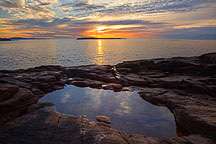Musings from Maine with Mel Copen
By Mel Copen August 13, 2011
 New Brunswick, Maine (August 18, 2011) – I’m tired of writing about “disfunctionalities” in our nation’s governance system, in the foibles of much of corporate America or the erosion of civility that seems to be occurring. As this column starts its 13th year, I thought I would focus on “something positive.” Even the jokes being directed at Congress and the economy seem to add to a malaise that is creeping over this nation. So I decided to take a break from the subject material and literally, a break from the normal routine. I figured “if they won’t go away, I would.”
New Brunswick, Maine (August 18, 2011) – I’m tired of writing about “disfunctionalities” in our nation’s governance system, in the foibles of much of corporate America or the erosion of civility that seems to be occurring. As this column starts its 13th year, I thought I would focus on “something positive.” Even the jokes being directed at Congress and the economy seem to add to a malaise that is creeping over this nation. So I decided to take a break from the subject material and literally, a break from the normal routine. I figured “if they won’t go away, I would.”
During the last few weeks, my wife, Beverly, and I spent time wandering, with family, along the Coast of Maine and New Brunswick. It is a wonderful area – endowed with natural beauty, picturesque seaport villages and fascinating elements of history. I thought I would share part of our experience – with the thought that it might entice others to get away and, at least temporarily, put aside the cares of the world.
 The Maine coast is only a bit more than 200 miles long, as the crow flies. But if you got your information from that crow as you started to walk it, you would be in for a surprise. You would reach the end of your journey 3,400 miles later – and that is if you skip visiting any of its islands. Approximately 3,000 of these dot the coast line, some little more than a few rocks above water when the tide is in, others substantial, supporting thriving communities (some of people and some of seals and birds), and everything in between. The largest of these, Mount Desert Island, houses a number of charming villages and the magnificent Acadia National Park.
The Maine coast is only a bit more than 200 miles long, as the crow flies. But if you got your information from that crow as you started to walk it, you would be in for a surprise. You would reach the end of your journey 3,400 miles later – and that is if you skip visiting any of its islands. Approximately 3,000 of these dot the coast line, some little more than a few rocks above water when the tide is in, others substantial, supporting thriving communities (some of people and some of seals and birds), and everything in between. The largest of these, Mount Desert Island, houses a number of charming villages and the magnificent Acadia National Park.
The southern portion of Maine’s coast line is well developed, with many villages catering to tourists and sandy beaches. But as one goes further north (actually “down east”) the signs of human encroachment become fewer and fewer and the coast becomes rugged, met by dense forests on top of impressive rock cliffs and pounding waves.
I have traveled here many times before, although this was Beverly’s first time in New Brunswick. Aside from a specific (and successful) intent to decimate the lobster population as we traveled (lobster for lunch, for dinner, and occasionally for breakfast and in-between snacks) our focus was on some of those off-shore islands.
The history of these islands is fascinating – it includes Native American settlements, pirates, battle grounds between the French and British and again during the Revolution, booze smugglers during prohibition times. Some were major ports of entry for trade between Europe and the fledgling U.S. Only 40 or so are inhabited, many with permanent populations under 100. Some relics of the past exist but today, artists’ colonies, lobster fishermen, picturesque light houses and magnificent seacoast scenery predominate.
The first Island we visited on this trip was an incredible experience – Machias Seal Island. A half-hour boat ride from the coast of Maine, the island is claimed by both the United States and Canada – although Canada currently has possession. Only 20 acres in size, it houses a lighthouse and its keepers and, at this time of year, about 1,000 nesting pairs of Puffins, along with Razorbills, Common Murres and other birds – but the Puffins are the show. From blinds erected on the island you can watch these little, colorful, adorable, flying footballs as they go about their daily routines – just a few feet away. They live in burrows beneath the piles of rocks. You don’t have to be a bird-lover to enjoy the antics of these little creatures. It’s a photographer’s paradise. And then, as we left and circled the island, a colony of seals on the rocks and in the water showed as much curiosity towards us as we did towards them.
We also visited Campobello Island which is about 15 square miles in size and has a permanent population of approximately 1,000. The island is Canadian, but it was the summer home for many years of the Roosevelt Family. Franklin Delano Roosevelt’s parents established a summer home here in 1883. He spent much of his childhood on the island and it served as his summer retreat through 1939. Unfortunately, it is also the location where, in 1921 he was diagnosed with polio. The “cottage” and surrounding gardens (beautiful flowers, well maintained – as is so typical of many parks in Canada) is somewhat unique in that it is operated by both the US and Canadian governments, although it is on Canadian soil. One could easily see why the President sought out its peace and tranquility in the midst of the nation’s turmoil in the early days of his administration. An additional and major charm of Campobello is that it is connected to the mainland by a short bridge to Lubec, Maine, a small (population 1600), extremely picturesque seacoast town.
A very different experience was Grand Manan Island. Also Canadian, Grand Manan is big enough to support a large, car-ferry service. About an hour and a half out from the mainland, the 53 square mile island is home to a permanent population of 2,500 and many more in the summer months The southern part of the island is almost completely undeveloped, with dramatic cliffs and heavily forested areas – a great place for hikers and people who just want to get away. An added bonus here is the strong likelihood of sighting whales, dolphins, seals and many sea-birds on the ferry trip. Grand Manan is at the mouth of the Bay of Fundy, and although the tides are not as high here as they are further up, they are still impressive (tides in the Bay are the highest in the world and can vary by as much as 50 feet).
 We also revisited one of my favorite spots – Monhegan Island. About an hour’s boat ride from the coast, it covers less than a square mile and has a permanent population of approximately 60 people. With a picture-perfect light house and a simple but beautiful harbor, entry to the Island is charming. The island now sports a number of shops and places to eat and stay – much more than on my previous visits – but many who come out, as we did, are day-trippers. The fascinating part of the visit is to cross the island through its deep moss-covered forests and emerge on the other side on top of spectacular rocky cliffs where you look down on the birds flying over the crashing waves. On at least one of the trails, people have used sticks, leaves, rocks and other native materials to create dozens of fairy houses. It’s easy to see why the island attracts so many artists.
We also revisited one of my favorite spots – Monhegan Island. About an hour’s boat ride from the coast, it covers less than a square mile and has a permanent population of approximately 60 people. With a picture-perfect light house and a simple but beautiful harbor, entry to the Island is charming. The island now sports a number of shops and places to eat and stay – much more than on my previous visits – but many who come out, as we did, are day-trippers. The fascinating part of the visit is to cross the island through its deep moss-covered forests and emerge on the other side on top of spectacular rocky cliffs where you look down on the birds flying over the crashing waves. On at least one of the trails, people have used sticks, leaves, rocks and other native materials to create dozens of fairy houses. It’s easy to see why the island attracts so many artists.
There are many other islands to explore, and much to do and see along the Maine and New Brunswick coasts. But the important thing is, from time to time, to just get away and put everything else aside. It’s hard to think about the trials and tribulations of the nation and the world or to entertain negative thoughts when you are surrounded by the beauty of the islands and the sea. Perhaps we should relocate Congress to one of these isles???
© Mel Copen, August, 2011
————————————————




